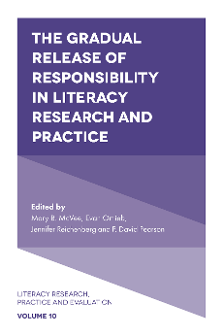
The Gradual Release of Responsibility in Literacy Research and Practice
ISBN: 978-1-78769-448-4, eISBN: 978-1-78769-447-7
ISSN: 2048-0458
Publication date: 26 August 2019
Citation
(2019), "", McVee, M.B., Ortlieb, E., Reichenberg, J.S. and Pearson, P.D. (Ed.) The Gradual Release of Responsibility in Literacy Research and Practice (Literacy Research, Practice and Evaluation, Vol. 10), Emerald Publishing Limited, Leeds, pp. 265-270. https://doi.org/10.1108/S2048-045820190000010017
Publisher
:Emerald Publishing Limited
Copyright © 2019 Emerald Publishing Limited
INDEX
Index
Note: Page numbers followed by “n” with numbers indicate notes.
- Prelims
- Chapter 1: In the Beginning: The Historical and Conceptual Genesis of the Gradual Release of Responsibility
- Chapter 2: We Must Know What They Know (And So Must They) For Children to Sustain Learning and Independence
- Chapter 3: Releasing Responsibility for What? Developing Learning Environments for Text-Based Inquiry in the Disciplines in Secondary Schools
- Chapter 4: The Ebb And Flow of Scaffolding: Thinking Flexibly About the Gradual Release of Responsibility During Explicit Strategy Instruction
- Chapter 5: Sustainable School Improvement: The Gradual Release of Responsibility in School Change
- Chapter 6: Leading Learning Through a Gradual Release of Responsibility Instructional Framework
- Chapter 7: Gradually Releasing Responsibility in Justice-Centered Teaching: Educators Reflecting on a Social Justice Literacy Workshop on Police Brutality
- Chapter 8: Gradual Release in the Early Literacy Classroom: Taking Languaging into Account with Emergent Bilingual Students
- Chapter 9: Employing the Gradual Release of Responsibility Framework to Improve the Literacy Instruction of Emergent Bilingual Students in the Elementary Grades
- Chapter 10: Scaffolding Development of Self-Regulated and Strategic Literacy Skills in Deaf or Hard-of-Hearing Students: A Review of the Literature Through the Lens of the Gradual Release of Responsibility Model
- Chapter 11: Literacy Coaching for Agentive and Sustainable Teacher Reflection: Joint Action within a Gradual Release of Responsibility as Apprenticeship
- Chapter 12: “See, You Can Make Connections with the Things You Learned Before!” Using the GRR to Scaffold Language and Concept Learning in Science
- Chapter 13: Passing the Pen: A Gradual Release Model of the Recursive Writing Process
- Chapter 14: Think Aloud, Think Along, Think Alone: Gradually Releasing Students to Use Comprehension Strategies in Elementary Classrooms
- Chapter 15: Sustaining Culture, Expanding Literacies: Culturally Relevant Literacy Pedagogy and Gradual Release of Responsibility
- Chapter 16: Epilogue: Reflections on the Gradual Release of Responsibility Model: Where We’ve Been and Where We’re Going
- Index